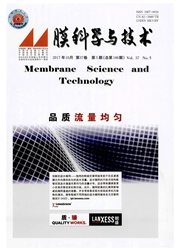

 中文摘要:
中文摘要:
以水体中经常暴露的消炎镇痛类药物萘普生(NAP)为研究对象,考察了溶液pH、离子强度(以Ca2+浓度表示)、共存腐殖酸浓度、操作压力和温度对纳滤膜去除NAP效能的影响.试验发现:溶液pH值、离子强度或腐殖酸浓度的增加均提高了纳滤膜对NAP的去除率,操作压力的增加则使NAP的去除率有所降低,当溶液温度在16.5~36.5℃范围内变化时未对NAP的去除率产生明显影响.在所有试验条件下,纳滤膜对NAP的去除率介于83.9%~96.2%之间,说明纳滤膜分离工艺是去除饮用水中微量NAP的一种有效方法,分析认为静电排斥和筛分作用是纳滤膜去除NAP的主要机制.
 英文摘要:
英文摘要:
Naproxen,an anti-inflammatory analgesic and detected frequently in aquatic environments,was selected as a target compound in this study.The effects of different factors including solution pH,ionic strength,humic acid concentration,operating pressure and temperature on the removal of naproxen by nanofiltration membrane separation were investigated in detail.The results showed that the removal efficiency of naproxen was improved with the increase of solution pH,ionic strength and humic acid concentration.However,the removal efficiency of naproxen decreased with increasing operating pressure.Variation of temperature in the range 16.5 to 36.5 ℃ did not affect the removal efficiency of naproxen.Under the experimental conditions employed,the removal efficiency of naproxen varied from 83.9% to 96.2%,which demonstrated that nanofiltration membrane separation is an effective method for the removal of trace naproxen from drinking water.Electrostatic repulsion and steric exclusion have been proposed as the dominant mechanisms for the retention removal of naproxen by nanofiltration membrane separation.
 同期刊论文项目
同期刊论文项目
 同项目期刊论文
同项目期刊论文
 Photodegradation of amoxicillin in aqueous solutionunder simulated irradiation: influencing factorsa
Photodegradation of amoxicillin in aqueous solutionunder simulated irradiation: influencing factorsa Co-production of activated carbon, fuel-gas, and oil from the pyrolysis of corncob mixtures with wet
Co-production of activated carbon, fuel-gas, and oil from the pyrolysis of corncob mixtures with wet Removal of five selected pharmaceuticals by coagulation in the presence of dissolved humic acids and
Removal of five selected pharmaceuticals by coagulation in the presence of dissolved humic acids and Photodegradation of amoxicillin in aqueous solution under simulated irradiation: influencing factors
Photodegradation of amoxicillin in aqueous solution under simulated irradiation: influencing factors Contribution of sludge adsorption and biodegradation to the removal of five pharmaceuticals in a sub
Contribution of sludge adsorption and biodegradation to the removal of five pharmaceuticals in a sub Determination of selected pharmaceuticals in tap water and drinking water treatment plant by high-pe
Determination of selected pharmaceuticals in tap water and drinking water treatment plant by high-pe Influencing factors and degradation behavior of propyphenazone and aminopyrine by free chlorine oxid
Influencing factors and degradation behavior of propyphenazone and aminopyrine by free chlorine oxid 期刊信息
期刊信息
